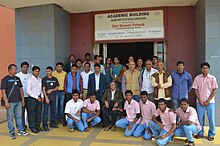Wikimedia Blog/Drafts/Odia Wikipedia: Three years of active contributions gives life to a ten years old project
|
This page is currently a draft. More information pertaining to this may be available on the talk page. Translation admins: Normally, drafts should not be marked for translation. |
Title
[edit]Odia Wikipedia: Three years of active contributions gives life to a ten years old project
Body
[edit]
Odia Wikipedia has completed ten years 29th of January this year. Though this was started as one of the first four Indic language Wikipedias the real contribution started in 2011. Back then with 550 odd articles and practically no contributors the initial Wikipedians struggled for few months to reach out to more people, argue upon using the right kind of standard of language and writing for the content and interface system messages. But, with more people coming on the Internet - primarily on social media platforms and language input becoming easier such collaborative platforms started getting more visibility. Odia Wikipedia's facebook page and group became the social gateway for welcoming more people to get used to type in Odia language. This is one of the languages which has very little online presence when it comes to having content as Unicode text. Availability of images, audio and video files is far too less than the same amount of media files available in any place of same geographical area. Many people still struggle with the outdated pirated operating systems installed in their computers which added more hurdles in the way of all the community led Wikipedia outreach programs. There has been more developments in the recent days in language input and online contribution in Odia. More people started searching for online content using Odia in Unicode. This is where Odia Wikipedia played a crucial role of having massive growing content that is reflected in the readership. Monthly page views which remained consistently low over the years started growing from less than 1000 to more than 400,000 and times hitting 500,000 mark. This is highest among all the websites that have Odia content. With new projects that interest more people to write articles and edit Wikipedia Odia Wikipedia has celebrated its 10th anniversary over two days. Odia Wikipedians gathered in two different educational institutes; at Kalinga Institute of Social Sciences in Bhubaneswar on the 28th of January and Indian Institute of Mass Communication in Dhenkanal on the 29th.
Day 1:

First day of Odia Wikipedia 10 began with the traditional Chhena poda cutting by noted linguist Padmashree Dr. Debiprasanna Patnaik. Kalinga Institute of Social Sciences (KISS) has recently collaborated with The Centre for Internet and Society for the resource gathering, documentation and archival about the 62 tribal communities of Odisha and neighboring eastern Indian states and initiating Wikipedia projects in the indigenous tribal languages. The first few phase of workshop brought about 15 students pursuing their masters in Arts, Science and Commerce disciplines and 10 faculty members. This project also will also dovetail into the Mother Tongue based Multilingual Lab that has been set up in the institute to set up an education system by creating educational materials in tribal languages. Dr. Patnaik spoke to these contributors about the native languages and the importance of documenting the language and cultural heritage online. Subrat Prusty, General Secretary of Janasammilani and founding member of Odia Biswabidyalaya gave a talk on the factors that has diminished the native languages and how collaborative efforts could bring dying languages to revive with the promise of sharing a 5000 word dictionary in Odia in free license. With the audio recording of Dr. Patnaik introducing himself, Odia Wikipedians inaugurated the Voice intro project as the first Indic language project. Odia Wikipedians interacted with the students and teachers at KISS to get their inputs on the kind of knowledge imparted by introducing Wikipedia editing. Later these will streamline the process of writing to the linguistic team for pledging for the classical language status of Odia.
Day 2:

The second day of Odia Wikipedia 10 was celebrated in the Indian Institute of Mass Communication (IIMC) Dhenkanal campus which was also celebrated in the campus. Students who had participated in the series of Odia Wikipedia workshops earlier this year took part in this event. Sampad Mohapatra, noted TV and print media journalist inaugurated this event formally by lighting Dipa and cutting a birthday Chenapoda. Mohapatra shared his experience how the entire media industry relies on Wikipedia for collecting information and how contribution in regional languages will benefit the students in the context of shift of more job availability in the regional media. Professor Dr. Mrinal Chatterjee who heads the institution shared the accessing knowledge ways since ages that is slowly moving to internet based search. He discussed about various strategies of bringing more online content in regional languages that will help the academia and the students. Usha Padhee, Secretary of Mass Education Department, Odisha Government distributed awards to the top most Wikipedia contributors. She later presented about the role of media in educating a society and Open Educational Resources in new tools of imparting knowledge.
- More information about the event (In Odia): https://or.wikipedia.org/wiki/WP:OdiaWikipedia10
- Images, audio and video files: Commons:Category:OdiaWikipedia10
Notes
[edit]- Odia Wikipedia 10 day 1 - KISS group photo by Subhashish Panigrahi. CC-BY-SA 3.0 Unported.
- Prasanna Pattanayak introducing himself for Voice intro project.jpg Debiprasanna Patnaik introducing himself for Voice intro project by Jnanaranjan Sahu
- Chenapoda cutting during Odia Wikipedia 10 celebration at Indian Institute of Mass Communication, Dhenkanal by Mrutyunjay Kar. CC-BY-SA 3.0 Unported.
-- By Subhashish Panigrahi, Programme Officer, Access To Knowledge, Centre for Internet and Society (CIS-A2K).
